Kinesiology Unit 2 Muscles
General
o There are more then 600 muscles in the body
o Move in and out
o To stabilize
o They are having to move together
o There is voluntary or involuntary from nerve system (3 groups of function and structure)
o Smooth: involuntary, eating
o Skeletal: voluntary, breathing, moving
o Cardiac: involuntary, heartbeat
o Muscle is attached to bone through a tendon
o Origin: the proximal location, the part that is more stationary
o Insertion: the distal end, the part that moves the most
o In contraction: insertion moves towards the origin
o Muscle makes up 40% of your total body weight
Muscle Tissue
o Just a collection of cells
o Shortens during contraction (tension is created moving)
o Achieved through tendons à tough bands that move the bones with the force of the muscle
o Three types
o Skeletal
o Uses of tendons
o Most prevalent
o Conscious control and striated à BECAUSE OF ORGANIZATION OF SARCOMERES AND MYOFILAMENTS
o Cardiac
o Only in the heart
o Striated (not as much as skeletal) is directed by the autonomic nervous system
o Pumps blood from heart to body
o Smooth
o Surrounds internal organs and hair follicles
o Spindle-shaped fibers in dense sheets (CANNOT STRENGHTEN)
o Contracts more slowly but remained contracted for longer periods of time
Properties of Muscle Fibres – KNOW
o Irritability: response to stimuli
o Contractability: Shorten in length
o Elasticity: Stretch and return to original position
o Extensibility: extend in length
o Conductivity: transmit nerve impulses
Agonist and antagonist
o All arranged in opposing pairs
o Always pull is one muscle will pull one direction then the other muscle when “relaxing”
o Agonist: primary responsible for movement (the one doing the work)
o Antagonist: the one that counters it is the agonist muscle (would lengthen)
o Stabilizer: provide support and holds the joint in place so that the movement may occur
Break down of the Muscle
o Muscle à Bundle (Fascicle) à Muscle fibres (millions make one fascicle) à Myofibril (One tube that can extend or flex) à Filaments (Where the Actin and Myosin is)
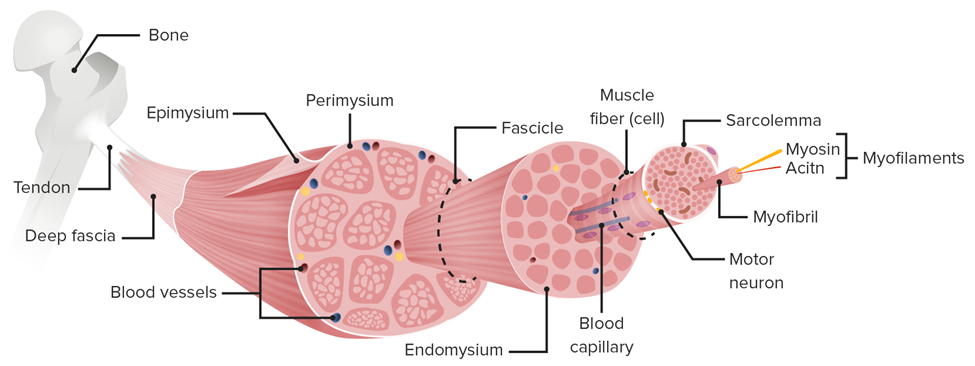
o Actin is the light, and the dark is the myosin when the muscle is striated
o Epimysium: Surrounds the entire muscle à connective tissue
o Endomysium: covers full bundle of fascicles that are held together by perimysium à connective tissue
o Sarcomeres: compartments in myofibrils that are the actin and myosin
o They are individual but when organizes end to end they make up myofilaments
Actin and Myosin
o Myosin
o Have a head (wants to stick into the actin) and a tail
o Head would attach and contact and pull in in a canoe motion
o That is what converts the ATP to ADP, which is usable, by removing a Pi molecule when attaching
o You get the ATP from food
o Actin
o Has binding sites for the myosin head
o Two proteins:
o Troponin: where the calcium goes (when bound they open up the spots to bind)
o Calcium: trigger for muscle contraction after nerve impulse
o Allows for actin and myosin to interact
o Relaxation is caused by re-uptake of calcium ions required for adenosine triphosphate
o ATP is used to detach
o As you work more = more use of muscle = more ATP used = more need = food need
o Tropomyosin: cordlike structure that covers binding sites (so you are not always contracting)
o Work like a swivel locking mechanism à only allow for binding once the calcium is released by the sarcoplasmic reticulum
o This is the excitation-contraction coupling à this protein filament interact at the molecule level that allows them to slide across one another, this is all about the nerve and muscle’s interaction together à leads Sliding Filament Theory, which is the allowing the synchronized action across the muscle
Thin and Thick Filament
o Thin: Actin
o Thick: Myosin
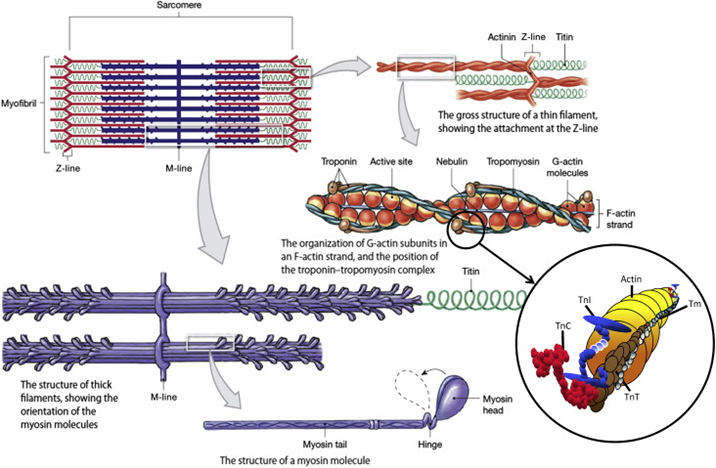
Sliding Filament Theory
o The muscles pull they don’t push
o A limb can push but only because of a muscle pulling on bone
o Contract if the load is light or heavy
o It will remain the same length if the load is equal to the muscle strength
o Contract due to actin sliding over myosin
o ATP turns into ADP which allows it to bind
o Order of movement:
o Motor nerves active muscle fibres from brain by sending action potential
o Head attaches
o Cross bridges (repeat like canoe) à (attach, rotate, detach, and reattach in rapid succession) à space between the actin and myosin
o The actin filament moves, and sarcomere shorten à I band shortens and H-zone shrinks (A-band stays the same)
o Optimal joint angle is 90-120 degrees
o Optimal number of cross bridges (Weird space between) à ALLOWS FOR MAXIUM FORCE
o Large: few cross bridges (sarcomeres are too far apart)
o Small: cross bridges interfere with each other (sarcomeres too close together)
NEED TO KNOW – TEST
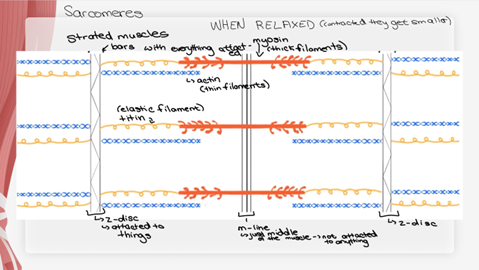
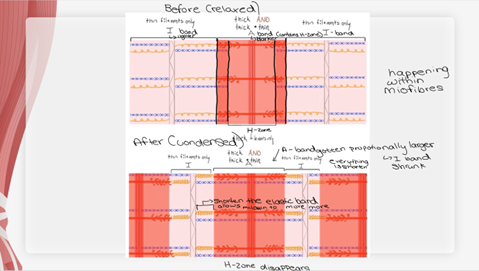
The Neuromuscular System
The Nervous System: Controls skeletal muscle and is activated à conscious control à bigger muscle is more nerves (from the peripheral (PNS))
The Motor Unit
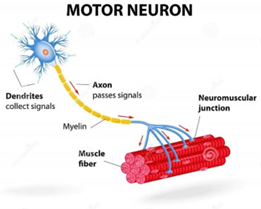
o Made up of the motor neuron (and its axon) and the muscle fibres it activates
o Nerves have a wave impulse (no jerky motion)
o A single nerve impulse with contraction à muscle twitch
o One neuron can be responsible for many muscles fibres
o It is the basic functional entity of muscular activity
o Even though the motor neuron can be attached to many muscle fibres they must all be the same type of muscle
o Each muscle can have more then one motor unit
o Delicate and precise movement
o Many (1500-3000) motors per muscle
o Few (8-50) muscle fibres per unit
o Unrefined and powerful movement
o Few (600-2000) motors per muscle
o Many (1500) muscle fibres per units
o Larger body mass = motor units contain more muscle fibres
All or None Principle
o Can be categorized into small or large unites
o Large: produce large (gross) movement
o Small: fewer muscle fibres so there are finer motor movement
o Smaller because they have fewer muscle fibres than fast twitch motor units (EYES)
o Single motor units in the quad can simulate 300 to 800 muscle fibres
o For maximal muscle fore to be produced all motor unites within that muscle group must be recruited à all to contract or it does not contract à must be at the same time fire and contract
o ALL OR NONE PRINCIPLE à all motors units need to comply à when a motor unit is simulated to contract, it will do so its fullest potential
Activation Threshold
o Has a specific threshold that it must be reached for activation
o Weak nerve impulse = weak threshold (smaller Muscle that has it)
o Stronger nerve impulse = stronger muscle = stronger threshold
o This is because of the actin and myosin working together à This is part of the excitation-contraction coupling
o As resistance increases, more motor units must be activated by stronger more intense impulse
o If you need to pick up something heavy then you need more of an contraction which means more of an impulse needed to work them
Link Between the Muscular and Nervous System
Junction Point: EXAM
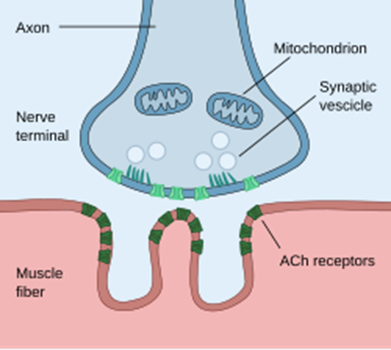
o Nervous system à impulses originating in the brain and spinal cord
o Both system of the central and the peripheral nervous system working together
o Muscle twitch: single nervous impulse and resulting contraction
o The motor neuron, its axon, and the muscle fibres all stimulate together
o Neuromuscular junction: nerves transmit messages directing the muscle to move
o ACETYLCHOLINE is released when there is a contact point between the nerve and the muscle
o This chemical is then received to ACh receptors which then releases the calcium from the sarcoplasmic reticulum
o Then the chemical is detected by receptors on the surface of the muscle contraction (By activating the movement of troponin) Such as à contract smooth muscle, slow heart rate, and dilate the blood vessels
o Area where nerves and muscle meet and pass on message
o There is a space between the 2 that is extremely small that is in between the nerve and muscle called the synapsis
o This is the principle of energy transfer: electrical energy to the surface of muscle fibres
Excitation-Contraction Coupling
o Muscle contraction as a whole
o Begins with electrical signal from spinal cord, down the nerves at the neuromuscular junction, to the contact point of the motor nerve with the muscle fibre. Once the signal has transmitted across the synapse the muscle is contracted with the release of acetylcholine.
1. Electrical signal that begins starts in the spinal cord and moves along the axon to the junction
2. Then the signal is moved down to the muscle fibre through the tubular membranes and by the release of acetylcholine
3. Calcium ions are then released into the sarcoplasm reticulum
4. The interaction of calcium of the protein troponin and tropomyosin moves to have actin and myosin interact
Muscle Fibre Types
o Fast Twitch
o Type II
o Appearance is white/clear
o Fast contraction à cannot be sustained for a long period of time
o Anaerobic à does not need oxygen
o Large fibres (Think of someone ripped)
o Slow Twitch
o ST or Type I
o Appears red
o Slow contraction à can be sustained for a long period of time
o Aerobic
o Fatigue resistant
o Small fibres (Think of someone who is lean)
o YOU CAN NOT SWITCH ONE TYPE OF FIBRE TO ANOTHER BUT YOU CAN IMPROVE THE FIBRES WITH THE TYPE OF TRAINING YOU DO
Myoglobin
o Difference in fibre type are main do to the extent to which a particular muscle relies on oxygen in the production of energy
o Myoglobin = protein
o They store oxygen and delivers it to the muscles, thus allowing energy production to sustain over a long period of time
o More aerobic processes the more it can sustain longer-term activity
o Slow Twitch: high in myoglobin à endurance
o Fast Twitch: Low in myoglobin à concentrated and shorter burst of energy
o Faster is white because there is less myoglobin and oxygen à there are capillaries in the muscle so to allow the blood to get to the muscles à gain energy form the sugar glycogen instead of oxygen
Nerve-Muscle Interaction and Adaptation
o INTRA-MUSCLE COORDINATION à all in the same muscle
o the ability to activate all motor units simultaneously
o this is impossible so we try to be as efficient as possible à normal is about 60%, athlete is 85%
o MUSCLE FORCE DEFICIT à difference between assisted and voluntarily generated maximal force à at some point you cannot do the action anymore as you are so tired and the muscle need to rest à this is because of vigorous exercises
o Trained athletes though have a larger number of muscle fibres and larger muscle mass à more limited in further strength gains à they are very strong so can’t get any stronger
o INTER-MUSCLE COORDINATION à in different muscles
o The ability to activate different muscles to produce a movement
o Especially the interplay between the agonist and antagonist
o They must be synchronously activated and relaxed
o The greater the participation of muscles/groups the higher the importance of the inter-muscle coordination
Muscle Adaptation to Strength Training
o Biological adaptation à performance improvement through strength training à increased strength
o Performance capacity of a muscle is determined by several factors:
o Fibre diameter
o Intra- and inter- muscle coordination
o Nerve impulse frequency
o Muscle and tendon elasticity
o Energy stores
o Capillary density
o Non-trainable factors:
o Muscle fibre type
o Structure of muscle fibres
o Different factors adapt at different rates
 Knowt
Knowt